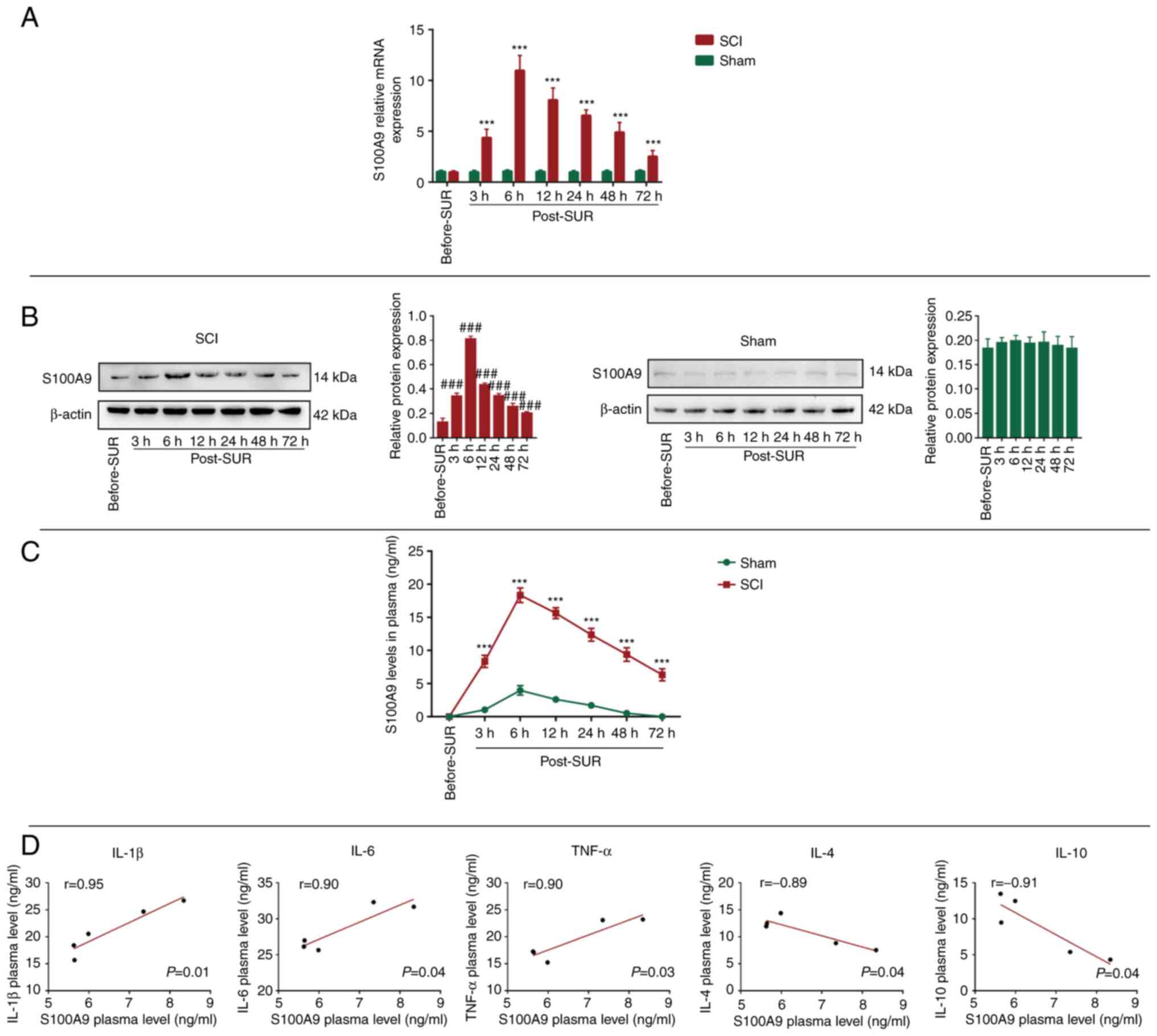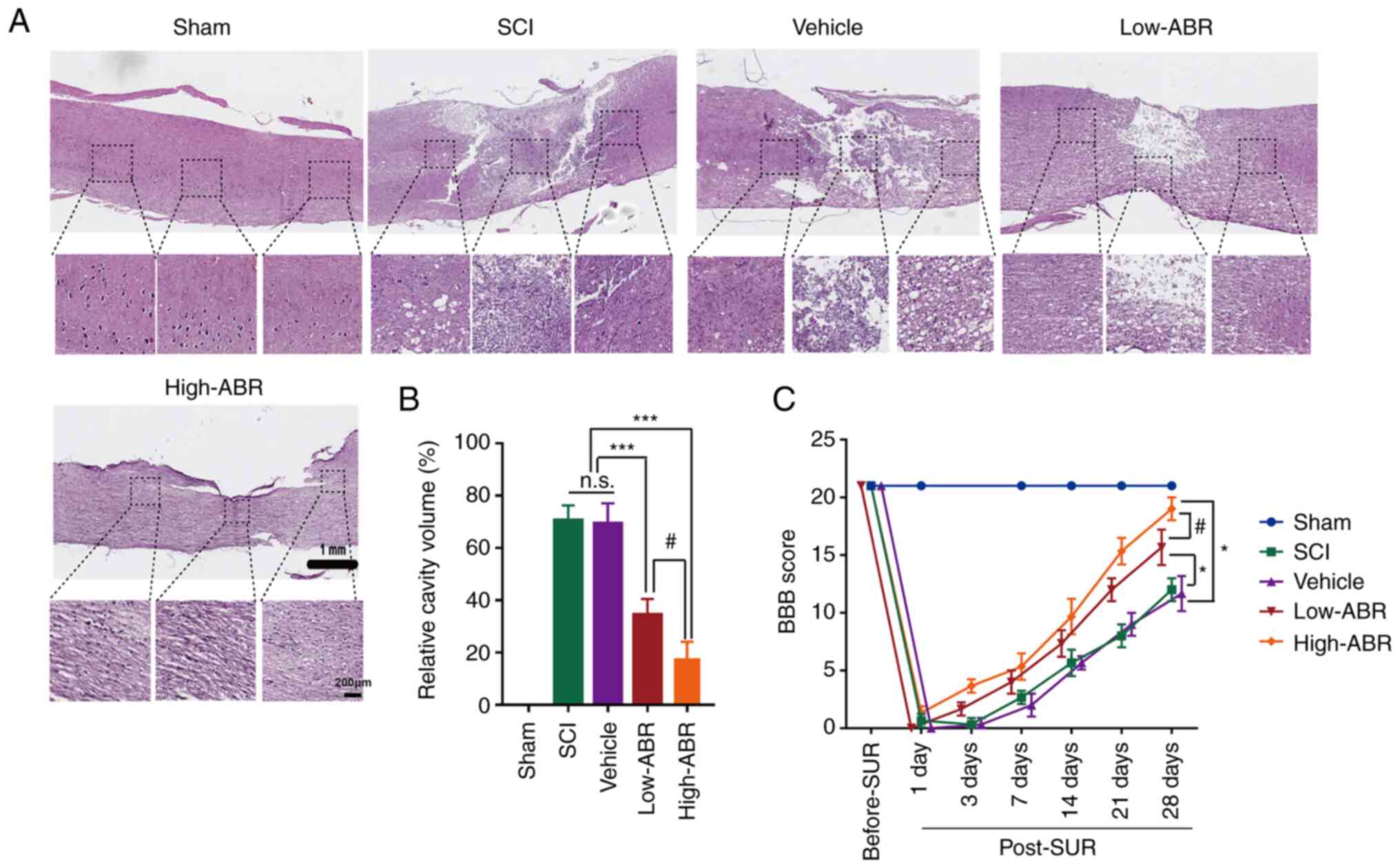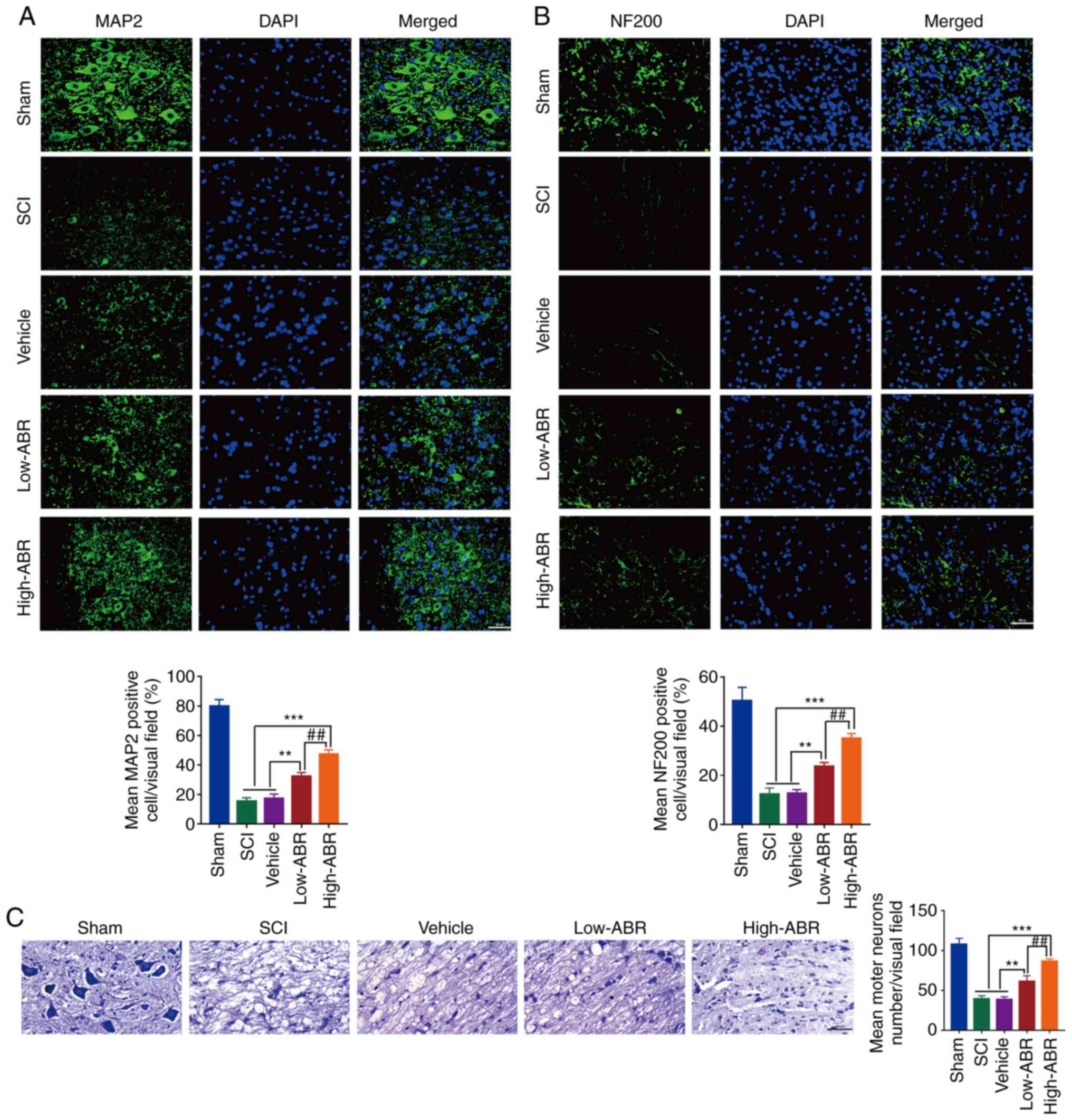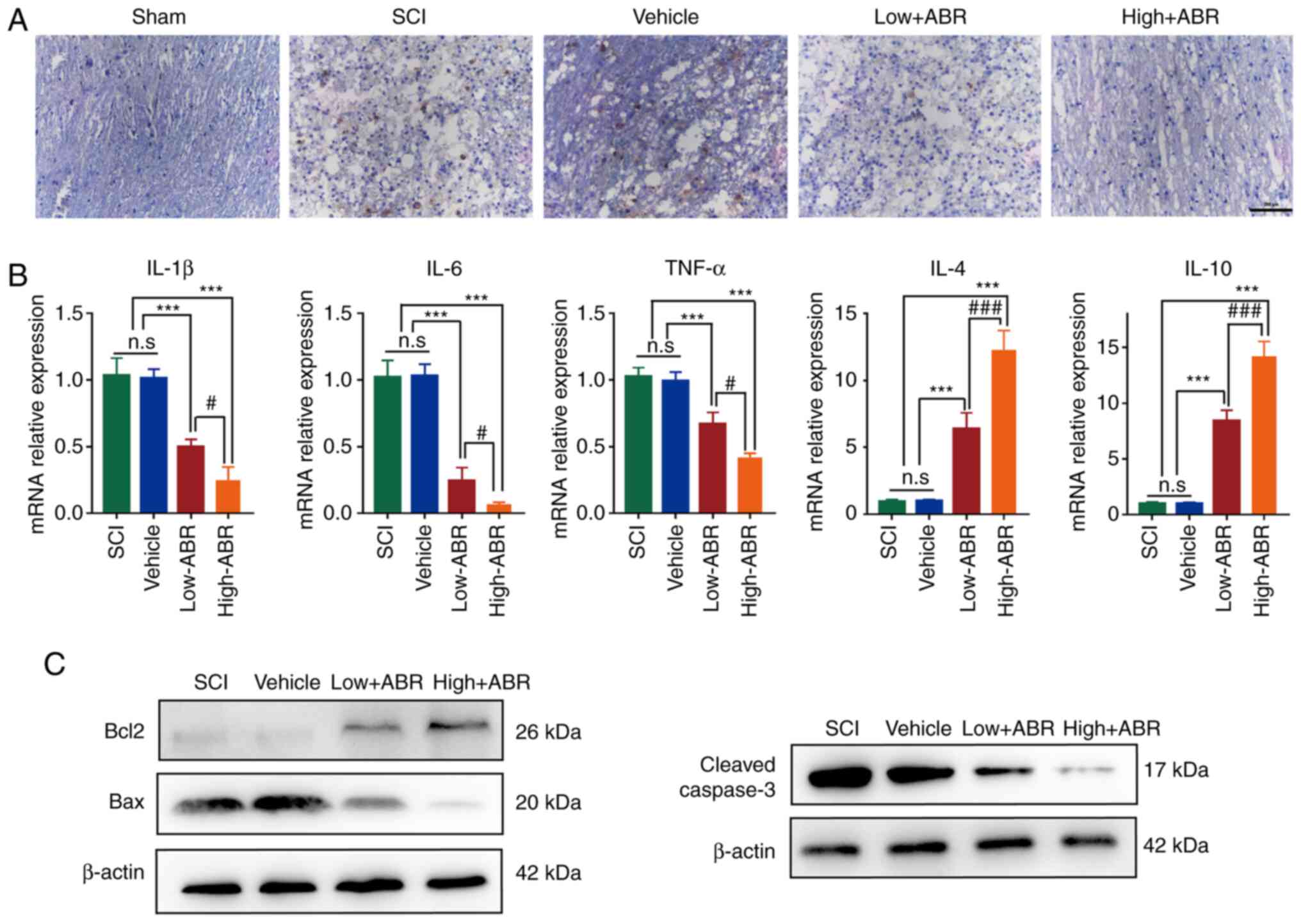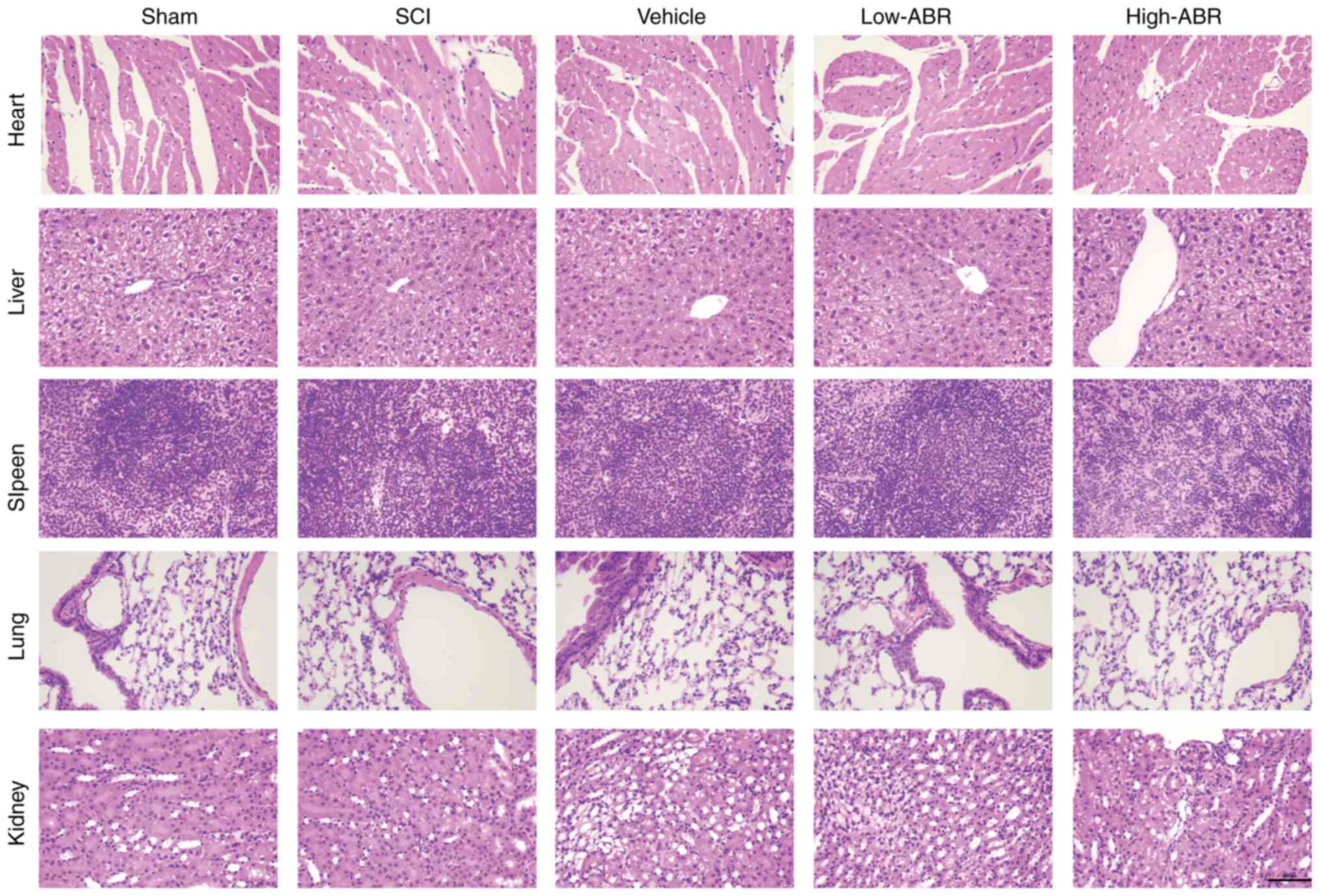|
1
|
Hutson TH and Di Giovanni S: The
translational landscape in spinal cord injury: Focus on
neuroplasticity and regeneration. Nat Rev Neurol. 15:732–745.
2019.PubMed/NCBI View Article : Google Scholar
|
|
2
|
Dwyer-Lindgren L, Bertozzi-Villa A, Stubbs
RW, Morozoff C, Kutz MJ, Huynh C, Barber RM, Shackelford KA,
Mackenbach JP, van Lenthe FJ, et al: US county-level trends in
mortality rates for major causes of death, 1980-2014. JAMA.
316:2385–2401. 2016.PubMed/NCBI View Article : Google Scholar
|
|
3
|
National SCI Statistical Center: Facts and
figures at a glance. University of Alabama at Birmingham, AL, USA,
2019.
|
|
4
|
Ahuja CS, Nori S, Tetreault L, Wilson J,
Kwon B, Harrop J, Choi D and Fehlings MG: Traumatic spinal cord
injury-repair and regeneration. Neurosurgery. 80 (Suppl 3):S9–S22.
2017.PubMed/NCBI View Article : Google Scholar
|
|
5
|
Jones TB: Lymphocytes and autoimmunity
after spinal cord injury. Exp Neurol. 258:78–90. 2014.PubMed/NCBI View Article : Google Scholar
|
|
6
|
Nakamura M, Houghtling RA, Macarthur L,
Bayer BM and Bregman BS: Differences in cytokine gene expression
profile between acute and secondary injury in adult rat spinal
cord. Exp Neurol. 184:313–325. 2003.PubMed/NCBI View Article : Google Scholar
|
|
7
|
Chan JK, Roth J, Oppenheim JJ, Tracey KJ,
Vogl T, Feldmann M, Horwood N and Nanchahal J: Alarmins: Awaiting a
clinical response. J Clin Invest. 122:2711–2719. 2012.PubMed/NCBI View
Article : Google Scholar
|
|
8
|
Pruenster M, Vogl T, Roth J and Sperandio
M: S100A8/A9: From basic science to clinical application. Pharmacol
Ther. 167:120–131. 2016.PubMed/NCBI View Article : Google Scholar
|
|
9
|
Li Y, Chen B, Yang X, Zhang C, Jiao Y, Li
P, Liu Y, Li Z, Qiao B, Bond Lau W, et al: S100a8/a9 signaling
causes mitochondrial dysfunction and cardiomyocyte death in
response to ischemic/reperfusion injury. Circulation. 140:751–764.
2019.PubMed/NCBI View Article : Google Scholar
|
|
10
|
Marinković G, Grauen Larsen H, Yndigegn T,
Szabo IA, Mares RG, de Camp L, Weiland M, Tomas L, Goncalves I,
Nilsson J, et al: Inhibition of pro-inflammatory myeloid cell
responses by short-term S100A9 blockade improves cardiac function
after myocardial infarction. Eur Heart J. 40:2713–2723.
2019.PubMed/NCBI View Article : Google Scholar
|
|
11
|
Zeng H, Liu N, Yang YY, Xing HY, Liu XX,
Li F, La GY, Huang MJ and Zhou MW: Lentivirus-mediated
downregulation of α-synuclein reduces neuroinflammation and
promotes functional recovery in rats with spinal cord injury. J
Neuroinflammation. 16(283)2019.PubMed/NCBI View Article : Google Scholar
|
|
12
|
Zhao B, Lu R, Chen J, Xie M, Zhao X and
Kong L: S100A9 blockade prevents lipopolysaccharide-induced lung
injury via suppressing the NLRP3 pathway. Respir Res.
22(45)2021.PubMed/NCBI View Article : Google Scholar
|
|
13
|
Basso DM, Beattie MS and Bresnahan JC: A
sensitive and reliable locomotor rating scale for open field
testing in rats. J Neurotrauma. 12:1–21. 1995.PubMed/NCBI View Article : Google Scholar
|
|
14
|
Bryan H, Timo N and Gemma P: The Cost
Manual of Laboratory Animal Care and Use. USA: CRC Press,
pp333-353, 2011.
|
|
15
|
Livak KJ and Schmittgen TD: Analysis of
relative gene expression data using real-time quantitative PCR and
the 2(-Delta Delta C(T)) method. Methods. 25:402–408.
2001.PubMed/NCBI View Article : Google Scholar
|
|
16
|
Wu Q, Wang Q, Li Z, Li X, Zang J, Wang Z,
Xu C, Gong Y, Cheng J, Li H, et al: Human menstrual blood-derived
stem cells promote functional recovery in a rat spinal cord
hemisection model. Cell Death Dis. 9(882)2018.PubMed/NCBI View Article : Google Scholar
|
|
17
|
Kovačić M, Mitrović-Ajtić O,
Beleslin-Čokić B, Djikić D, Subotički T, Diklić M, Leković D, Gotić
M, Mossuz P and Čokić VP: TLR4 and RAGE conversely mediate
pro-inflammatory S100A8/9-mediated inhibition of
proliferation-linked signaling in myeloproliferative neoplasms.
Cell Oncol (Dordr). 41:541–553. 2018.PubMed/NCBI View Article : Google Scholar
|
|
18
|
Lorey MB, Rossi K, Eklund KK, Nyman TA and
Matikainen S: Global characterization of protein secretion from
human macrophages following non-canonical caspase-4/5 inflammasome
activation. Mol Cell Proteomics. 16 (Suppl 1):S187–S199.
2017.PubMed/NCBI View Article : Google Scholar
|
|
19
|
Ramer LM, Ramer MS and Bradbury EJ:
Restoring function after spinal cord injury: Towards clinical
translation of experimental strategies. Lancet Neurol.
13:1241–1256. 2014.PubMed/NCBI View Article : Google Scholar
|
|
20
|
David S, López-Vales R and Wee Yong V:
Harmful and beneficial effects of inflammation after spinal cord
injury: Potential therapeutic implications. Handb Clin Neurol.
109:485–502. 2012.PubMed/NCBI View Article : Google Scholar
|
|
21
|
Orr MB and Gensel JC: Spinal cord injury
scarring and inflammation: Therapies targeting glial and
inflammatory responses. Neurotherapeutics. 15:541–553.
2018.PubMed/NCBI View Article : Google Scholar
|
|
22
|
Shah M, Peterson C, Yilmaz E, Halalmeh DR
and Moisi M: Current advancements in the management of spinal cord
injury: A comprehensive review of literature. Surg Neurol Int.
11(2)2020.PubMed/NCBI View Article : Google Scholar
|
|
23
|
Marino RJ, Ditunno JF Jr, Donovan WH and
Maynard F Jr: Neurologic recovery after traumatic spinal cord
injury: Data from the model spinal cord injury systems. Arch Phys
Med Rehabil. 80:1391–1396. 1999.PubMed/NCBI View Article : Google Scholar
|
|
24
|
Kirshblum S, Millis S, Mckinley W and
Tulsky D: Late neurologic recovery after traumatic spinal cord
injury. Arch Phys Med Rehabil. 85:1811–1817. 2004.PubMed/NCBI View Article : Google Scholar
|
|
25
|
Enzmann G, Mysiorek C, Gorina R, Cheng YJ,
Ghavampour S, Hannocks MJ, Prinz V, Dirnagl U, Endres M, Prinz M,
et al: The neurovascular unit as a selective barrier to
polymorphonuclear granulocyte (PMN) infiltration into the brain
after ischemic injury. Acta Neuropathol. 125:395–412.
2013.PubMed/NCBI View Article : Google Scholar
|
|
26
|
Bao F, Chen Y, Schneider KA and Weaver LC:
An integrin inhibiting molecule decreases oxidative damage and
improves neurological function after spinal cord injury. Exp
Neurol. 214:160–167. 2008.PubMed/NCBI View Article : Google Scholar
|
|
27
|
Nguyen HX, O'barr TJ and Anderson AJ:
Polymorphonuclear leukocytes promote neurotoxicity through release
of matrix metalloproteinases, reactive oxygen species, and
TNF-alpha. J Neurochem. 102:900–912. 2007.PubMed/NCBI View Article : Google Scholar
|
|
28
|
Nagareddy PR, Murphy AJ, Stirzaker RA, Hu
Y, Yu S, Miller RG, Ramkhelawon B, Distel E, Westerterp M, Huang
LS, et al: Hyperglycemia promotes myelopoiesis and impairs the
resolution of atherosclerosis. Cell Metab. 17:695–708.
2013.PubMed/NCBI View Article : Google Scholar
|
|
29
|
Cotoi OS, Dunér P, Ko N, Hedblad B,
Nilsson J, Björkbacka H and Schiopu A: Plasma S100A8/A9 correlates
with blood neutrophil counts, traditional risk factors, and
cardiovascular disease in middle-aged healthy individuals.
Arterioscler Thromb Vasc Biol. 34:202–210. 2014.PubMed/NCBI View Article : Google Scholar
|
|
30
|
Marinković G, Koenis DS, De Camp L,
Jablonowski R, Graber N, de Waard V, de Vries CJ, Goncalves I,
Nilsson J, Jovinge S and Schiopu A: S100A9 links inflammation and
repair in myocardial infarction. Circ Res. 127:664–676.
2020.PubMed/NCBI View Article : Google Scholar
|
|
31
|
Vogl T, Stratis A, Wixler V, Völler T,
Thurainayagam S, Jorch SK, Zenker S, Dreiling A, Chakraborty D,
Fröhling M, et al: Autoinhibitory regulation of S100A8/S100A9
alarmin activity locally restricts sterile inflammation. J Clin
Invest. 128:1852–1866. 2018.PubMed/NCBI View
Article : Google Scholar
|
|
32
|
Lin XY, Lai BQ, Zeng X, Che MT, Ling EA,
Wu W and Zeng YS: Cell transplantation and neuroengineering
approach for spinal cord injury treatment: A summary of current
laboratory findings and review of literature. Cell Transplant.
25:1425–1438. 2016.PubMed/NCBI View Article : Google Scholar
|
|
33
|
Li X, Xiao Z, Han J, Chen L, Xiao H, Ma F,
Hou X, Li X, Sun J, Ding W, et al: Promotion of neuronal
differentiation of neural progenitor cells by using EGFR antibody
functionalized collagen scaffolds for spinal cord injury repair.
Biomaterials. 34:5107–5116. 2013.PubMed/NCBI View Article : Google Scholar
|
|
34
|
De Filippo K, Dudeck A, Hasenberg M, Nye
E, van Rooijen N, Hartmann K, Gunzer M, Roers A and Hogg N: Mast
cell and macrophage chemokines CXCL1/CXCL2 control the early stage
of neutrophil recruitment during tissue inflammation. Blood.
121:4930–4937. 2013.PubMed/NCBI View Article : Google Scholar
|















